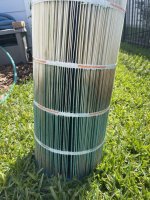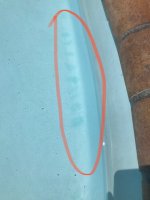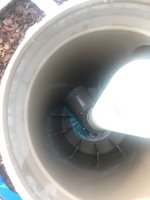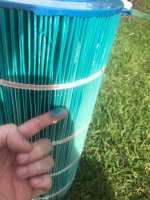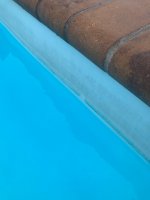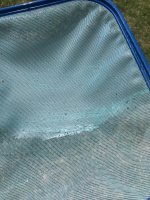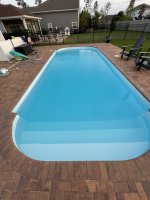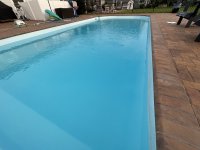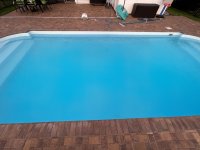Chemical Disaster -
- Thread starter LimaBeans
- Start date
You are using an out of date browser. It may not display this or other websites correctly.
You should upgrade or use an alternative browser.
You should upgrade or use an alternative browser.
Hi there! Any help appreciated.
2 weeks ago we opened our pool It was 80 degree and sunny. The water temperature was 68 degrees. We turned on our gas’s heater and by the next day it was a nice 86 degrees. I’ll be honest, we didn’t check the chemicals at that time. All we did was shock it and swim that weekend.
The next week we got a cold snap again and turned the heater off and have not used it since. This weekend we are close to 95 degrees so hoping our Florida weather is here to stay, we took a water sample to Pinch A Penny and got it checked. This was Wednesday 3/24/20 & the pool and the water from the naked eye looked fine. When they tested and printed out the results, EVERYTHING came back at 0 except Stabilizer.
The numbers seemed out of the norm.
Event since then:
Wednesday 3/242020:
We shocked the pool.
Added 5lbs of pH. Pinch a penny recommended 10lbs oh pH.
Added 6lbs of Calcium Hardness. Pinch a penny recommended 31lbs.
The above was added by mixing with 2.5lbs ph with water (2 different buckets) & 2lbs calcium with water in 3 bucket.
Within a couple of hours a blueish green undissolved powder was settling on the bottom of the pool and formed a film on top of the water.
The heater would not come on unless the pump was on high. We turned the heater off.
The pump still wasn‘t moving the water well with the heater off.
The filter is only a couple of months old. We pulled it out and we had never seen our filter look the way it did. It was green/blue and had a build up on it. We cleaned itvs d put it back in and it started performing again.
Note: This did not last for an extended period of time. We kept cleaning it and each time it got worse.
Thursday 3/25/2020:
Tested water at Pinch a penny again. (different person tested)
Because we had shocked it the chlorine read high.
- pH 7
- Alkalinity 50 PPM
- Calcium still 0 (recall they said it need 31lbs and we only put in 6lbs b/c we thought 31 was crazy)
- Stabilizer 100 PPM
They told us to add 4.8lbs of Alkalinity. For the calcium he said he very rarely sees calcium at a zero. He said to add 16 lbs, come back in 4 days and retest water and then add 16 more lbs.
We showed him pictures and he said not to get a new filter until we get it right. But, the filter is getting clogged quickly and we have to keep taking it out and cleaning it to get it going again.
None the less, we did as instructed and nothing.... the pool is completely foggy, the pump is not pulling, we cannot heat the water a d there is a film. Instead of waiting the 4 days went back today. It has only been 2 days but wanted to see where we are at.
Today 3/27/2020:
Pinch a penny result:
- 0 Chlorine, we have an in-line chlorine and you turned it in high today.
- pH 7.2
- base demand 3 drops
- alkalinity 70 PPM
- calcium hardness 50 PPM
- stabilizer 90 PPM
- total dissolved solids - 1000 PPM
They instructed us to put in 25 more lbs of calcium
We started the process of 10lbs every 2 hours.
When we showed them pictures of the cloudy pool and filter they said they think it’s the gel coat coming off the fiberglass shell. I messaged the company that installed our pool and they said it looks like a chemical build up and if it was the shell it would be brown.
It is a San Juan pool and it is only 2 years old. I can’t imagine it being the shell. The wall still feel smooth.
Pinch a penny didn’t tell us to replace the filter at this point.
The company that installed our pool said to take the filter out and run it to get the chemicals moving.
We are at a loss.....
Any advice is greatly appreciated. I am attaching pictures from over the last few days.
2 weeks ago we opened our pool It was 80 degree and sunny. The water temperature was 68 degrees. We turned on our gas’s heater and by the next day it was a nice 86 degrees. I’ll be honest, we didn’t check the chemicals at that time. All we did was shock it and swim that weekend.
The next week we got a cold snap again and turned the heater off and have not used it since. This weekend we are close to 95 degrees so hoping our Florida weather is here to stay, we took a water sample to Pinch A Penny and got it checked. This was Wednesday 3/24/20 & the pool and the water from the naked eye looked fine. When they tested and printed out the results, EVERYTHING came back at 0 except Stabilizer.
The numbers seemed out of the norm.
Event since then:
Wednesday 3/242020:
We shocked the pool.
Added 5lbs of pH. Pinch a penny recommended 10lbs oh pH.
Added 6lbs of Calcium Hardness. Pinch a penny recommended 31lbs.
The above was added by mixing with 2.5lbs ph with water (2 different buckets) & 2lbs calcium with water in 3 bucket.
Within a couple of hours a blueish green undissolved powder was settling on the bottom of the pool and formed a film on top of the water.
The heater would not come on unless the pump was on high. We turned the heater off.
The pump still wasn‘t moving the water well with the heater off.
The filter is only a couple of months old. We pulled it out and we had never seen our filter look the way it did. It was green/blue and had a build up on it. We cleaned itvs d put it back in and it started performing again.
Note: This did not last for an extended period of time. We kept cleaning it and each time it got worse.
Thursday 3/25/2020:
Tested water at Pinch a penny again. (different person tested)
Because we had shocked it the chlorine read high.
- pH 7
- Alkalinity 50 PPM
- Calcium still 0 (recall they said it need 31lbs and we only put in 6lbs b/c we thought 31 was crazy)
- Stabilizer 100 PPM
They told us to add 4.8lbs of Alkalinity. For the calcium he said he very rarely sees calcium at a zero. He said to add 16 lbs, come back in 4 days and retest water and then add 16 more lbs.
We showed him pictures and he said not to get a new filter until we get it right. But, the filter is getting clogged quickly and we have to keep taking it out and cleaning it to get it going again.
None the less, we did as instructed and nothing.... the pool is completely foggy, the pump is not pulling, we cannot heat the water a d there is a film. Instead of waiting the 4 days went back today. It has only been 2 days but wanted to see where we are at.
Today 3/27/2020:
Pinch a penny result:
- 0 Chlorine, we have an in-line chlorine and you turned it in high today.
- pH 7.2
- base demand 3 drops
- alkalinity 70 PPM
- calcium hardness 50 PPM
- stabilizer 90 PPM
- total dissolved solids - 1000 PPM
They instructed us to put in 25 more lbs of calcium
We started the process of 10lbs every 2 hours.
When we showed them pictures of the cloudy pool and filter they said they think it’s the gel coat coming off the fiberglass shell. I messaged the company that installed our pool and they said it looks like a chemical build up and if it was the shell it would be brown.
It is a San Juan pool and it is only 2 years old. I can’t imagine it being the shell. The wall still feel smooth.
Pinch a penny didn’t tell us to replace the filter at this point.
The company that installed our pool said to take the filter out and run it to get the chemicals moving.
We are at a loss.....
Any advice is greatly appreciated. I am attaching pictures from over the last few days.
No, we are not.Using copper algaecide, by chance?
When they tested and printed out the results, EVERYTHING came back at 0 except Stabilizer.
It's definitely copper.
If the pH and TA came back as 0, your heat exchanger is being destroyed.
Most likely, excessive use of tabs has caused the problem.
Wow..... no free chlorine yet the pool store is worried about calcium? I would have suggested that such warm water better get some chlorine in STAT or you're inviting algae to the party. 
Just an example of why we DO NOT TRUST POOL STORES with our pools. They're wrong more often than right, and without you having your own way to monitor and test your pool you're clueless to the damage they can cause you.
How are you chlorinating that pool? You *are* using chlorine, right?? Not Baqua or some crazy Ozone or UV device??
Maddie
Just an example of why we DO NOT TRUST POOL STORES with our pools. They're wrong more often than right, and without you having your own way to monitor and test your pool you're clueless to the damage they can cause you.
How are you chlorinating that pool? You *are* using chlorine, right?? Not Baqua or some crazy Ozone or UV device??
Maddie
I had replied before the threads were combined so only saw the pictures, but I agree with James. I have seen this exact thing after a TA crash acidified the water and destroyed a pool heater.
pH increaser is a bad choice, especially if you are adding calcium at the same time.
Adding sodium carbonate and calcium chloride at the same time is a recipe for disaster.
A better way would be to use baking soda until the pH was ok and then slowly increase the calcium.
Adding sodium carbonate and calcium chloride at the same time is a recipe for disaster.
A better way would be to use baking soda until the pH was ok and then slowly increase the calcium.
- May 3, 2014
- 62,745
- Pool Size
- 6000
- Surface
- Fiberglass
- Chlorine
- Salt Water Generator
- SWG Type
- Pentair Intellichlor IC-40
There's no way that the calcium level was zero. The people testing the water have no idea what they're doing.Why would the calcium hardness be 0??
We are using an in line chlorinator. We are usually set at around 2.5 with 5 being the max. We didn’t shock often during the winter but kept chlorinator stocked. We planned to start shocking weekly again in addition to the tabs when this all happened.Wow..... no free chlorine yet the pool store is worried about calcium? I would have suggested that such warm water better get some chlorine in STAT or you're inviting algae to the party.
Just an example of why we DO NOT TRUST POOL STORES with our pools. They're wrong more often than right, and without you having your own way to monitor and test your pool you're clueless to the damage they can cause you.
How are you chlorinating that pool? You *are* using chlorine, right?? Not Baqua or some crazy Ozone or UV device??
Maddie
Can you tell me more about the ”heat exchanger”? When you say excessive use of tabs are you referring to the chlorine tabs?It's definitely copper.
If the pH and TA came back as 0, your heat exchanger is being destroyed.
Most likely, excessive use of tabs has caused the problem.
The pool is 2 years old and we have only run heater a dozen time for an extended period of time. But, we always keep the heater valve open (I.e. water flowing through the heater. We also have a natural gas heater.
Thanks so much.
When you say TA is that the alkalinity? I apologize for all the 4th grader questions. New to all this.I had replied before the threads were combined so only saw the pictures, but I agree with James. I have seen this exact thing after a TA crash acidified the water and destroyed a pool heater.
I do not know the answer and the pool store said that rarely see 0 in results for calcium.Why would the calcium hardness be 0??
It is a fiberglass pool and they said that b/c there is no calcium it is eating the gel coat off the interior if the pool.
He did test it several times. He also tested water with calcium to show me what it should look like And it clearly was not the same.
Well, it appears we did the recipe for disaster. Not sure what to do now.pH increaser is a bad choice, especially if you are adding calcium at the same time.
Adding sodium carbonate and calcium chloride at the same time is a recipe for disaster.
A better way would be to use baking soda until the pH was ok and then slowly increase the calcium.
Also not sure how to check the heat exchanger referenced? Do all heaters electric and gas have them?
- May 3, 2014
- 62,745
- Pool Size
- 6000
- Surface
- Fiberglass
- Chlorine
- Salt Water Generator
- SWG Type
- Pentair Intellichlor IC-40
The heat exchanger is a coil made of copper that the water flows through while the natural gas is burned around it to heat the water. Low pH (and if your TA tested 0 your pH was 4.5 or lower) will eat the copper exchanger putting the copper in the pool water resulting in the blue you are seeing.Also not sure how to check the heat exchanger referenced?
Your extended use of trichlor (pucks, tablets) and not testing your pool water chemistry turned your pool water into an acidic stew.
The low CH (which I doubt could be that low) will not effect the gel coat of your pool.
That was a helpful, thank you.The heat exchanger is a coil made of copper that the water flows through while the natural gas is burned around it to heat the water. Low pH (and if your TA tested 0 your pH was 4.5 or lower) will eat the copper exchanger putting the copper in the pool water resulting in the blue you are seeing.
Your extended use of trichlor (pucks, tablets) and not testing your pool water chemistry turned your pool water into an acidic stew.
The low CH (which I doubt could be that low) will not effect the gel coat of your pool.
Sadly, the pool store is the only place I have ever had the water tested. We slacked off during the winter, lesson learned.
Do you have a recommendation on a user friendly way to test the water on my own?
Also, based on where we are now, what would your advice be to remedy where we are?
Correct.When you say TA is that the alkalinity?
I recommend that you get your own good test kit and check the chemistry and we can go from there.
I would not add any calcium chloride or calcium hypochlorite.
Thread Status
Hello , This thread has been inactive for over 60 days. New postings here are unlikely to be seen or responded to by other members. For better visibility, consider Starting A New Thread.
Similar threads
- Replies
- 7
- Views
- 249
- Replies
- 4
- Views
- 104
- Replies
- 16
- Views
- 359
- Replies
- 21
- Views
- 364


